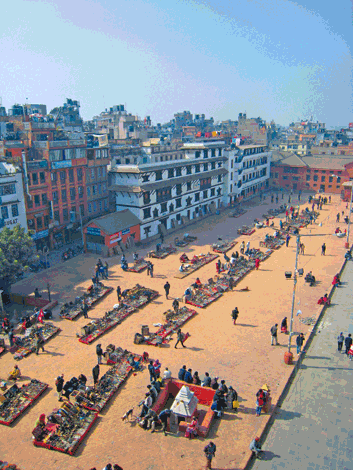“Most visitors have no interest in climbing Mount Everest,” explains a Nepalese tourism official who happens to sit next to me on an Air Asia X flight from Kuala Lumpur to Kathmandu. I’m wondering whether I should point out that she’s stating the obvious but decide it would be churlish to do so. Besides, she’s on a roll and quickly adds: “Fortunately, there are plenty of other activities for them in Nepal.”

Namche Bazaar
This, I decide, is just as well. When I stretch my legs in the aisle, eyeballing rows of fellow passengers, I decide that very few would make it to the summit of the world’s tallest mountain, anyway. Could their reluctance, I wonder, be more to do with lack of fitness than level of interest?
On descent, Himalayan peaks form a snowy rim near the horizon. Passengers, with few exceptions, wear bored expressions. It’s impossible to discern whether or not these are genuine. Nobody mentions that this is the much-celebrated 60th anniversary of Mount Everest’s conquest by pioneering Tenzing Norgay and a now-deceased New Zealander named Edmund Hillary. If they’re unaware of the milestone, posters to remind them await in Nepal’s capital.
The tourism official’s observation gets me thinking. The list of alternatives to climbing 8,848-metre Mount Everest – or even one of Nepal’s lesser peaks – is indeed long.
A 40-minute taxi ride through traffic-choked streets includes being trapped amid an intricate latticework of vehicles at an intersection – mercifully with the entertaining diversion of a monkey tightrope-walking over disused power cables.
Our destination: a Kathmandu institution called the Hotel Utse. Everyone seems to know this landmark. In other Asian cities (most of them considerably more expensive) I routinely check in at opulent five-star hotels – addresses ranging from grandly historic to modern and minimalist. Kathmandu has plenty of top-end lodgings, too - including converted former Rana palaces.

Sign from Hotel Utse
But the 48-room, four-floor Utse, a four-star with modest room rates, is always my preference. Room rates here range from US$22-40. Its outlets include a small rooftop bar overlooking the surrounding Thamel precinct and, on the ground floor, one of the capital’s best Nepalese cuisine eateries. Immaculately clean, it’s run by a helpful and cheery Tibetan family. Tip: book well ahead because the Utse is often full, particularly with foreign repeat visitors. Reservations can be made at www.utsehotel.com or +977 1425 7614.
Even though the overwhelming majority of visitors to Nepal don’t climb Everest, mountaineers complain of far too many climbers. Over 350 tackled the peak last year. What’s more, it’s not cheap. A few paid more than US$100,000 a head to be accompanied by private guides. Many, in upscale groups, forked out around US$40,000. “Budget” climbers got away with no more than US$25,000 each.
A fight earlier this year between demanding climbers and their Sherpa team highlighted antipathy from normally friendly and placid Nepalese towards so-called rich climbers who’ve rapidly driven up prices.
Climbs are often arranged by mountaineering associations in foreign countries. These associations warn wannabe conquerors to get fit and use reliable guides. Some climbers, according to veterans, are woefully inexperienced. Worse, their plastic water bottles and other detritus dot the route. Experienced mountaineers complain of being delayed by snail-paced groups.
Even though I haven’t packed crampons, I am pleased to discover there’s plenty for non-mountaineers to do in Kathmandu. For instance:
THAMEL
Ignore well-intentioned advice from friends sniffily dismissing this part of Kathmandu as “too touristy”. They’re much like visitors to Thailand who “absolutely adore the country so long as you get out of Bangkok” and seem oblivious to that city’s unique charms. Certainly, there are tourists aplenty in Thamel but for the time-poor there’s arguably no better place to soak up the sights and spicy smells of Kathmandu.

Thamel is a grid of narrow streets and even narrower alleys. Major streets are jammed with shops, shops and yet more shops selling fabric, made-in-Nepal clothing (some with designer labels at rock-bottom prices), handicrafts and souvenirs. Some emporia stock mountaineering, rafting and trekking gear. Bargaining is the norm but much less aggressive than in India. A Thamel plus is its preponderance of excellent English-language bookshops – which definitely merit browsing for reading matter for flights home.
Travel agencies, internet cafés, hotels, restaurants and “live music” bars pepper a relatively early-to-bed district where most establishments are shuttered by midnight and the only sound then heard is the mournful baying of stray dogs. Dusty laneways showcase traditional activities: carvers shaping marble; enormous cones of colourful spices; and butchers hacking giant slabs of meat.
DURBAR SQUARE
A left turn from the Utse starts a stroll through Thamel for about 15 minutes to reach World Heritage-listed Durbar Square, repository of some of Kathmandu’s historic gems. All-day tickets are sold in kiosks around the square and cost 750 Nepalese rupees (US$7.75). The square is a large rectangle around which sacred temples and other important edifices cluster. None is more important than Kumari Ghar (Kumari House) where Kathmandu’s Buddhist “living goddess” resides. A young girl, sometimes only a few years old, is chosen but replaced when she first menstruates or otherwise sheds blood – signalling that an ancient deity’s spirit has left her body.

While she’s a goddess she’s worshipped. Rules governing this quirky custom ban photography of her window from the courtyard below – in case the goddess is snapped while peering out. However, pictures of the heavily made-up “living goddess” are permitted when she’s carried through the streets during religious processions (when she isn’t allowed to smile or wave). The Royal Kumari – as she’s called, even though the monarchy ended five years ago – is revered by both Hindus (80.2 per cent of Nepalese) and Buddhists (10.7 per cent). The remainder are Islamic, Christians or followers of other faiths.
NATIONAL MUSEUM
Ride a taxi – past temples and imposing former palaces in distinctive Rana architectural style – to the National Museum. Housed in a 195-year-old building, it’s one of the capital’s grandest structures. Fascinating archaeological displays sit cheek-by-jowl with portrayals of Nepalese life through the centuries. Weaponry exhibits include equipment used by Gurkha fighters. An incorporated gallery displays historic Buddhist paintings along with works by contemporary Nepalese artists. Entrance is Rs50 (US$0.52).
PASHUPATINATH TEMPLE
Similarly close to most hotels is double-storey Pashupatinath, Kathmandu’s holiest and biggest Hindu temple, filled with ornate religious statuary. Termites reduced a previous temple on this site to dust. The current temple was built in the 17th century. While Pashupatinath is impressive, Kathmandu seems to have a temple on almost every corner and visitors are inevitably welcome. Also meriting exploration is the lively temple-studded twin city of Patan (with its own Durbar Square), adjoining Kathmandu. Entrance is Rs1,000 (US$10.30).
POKHARA
The country’s subtropical number-two city, a popular tourist destination, is 200km west of Kathmandu. The winding road is scenic but visitors usually prefer to go by air to a city where three of the world’s highest mountains form a picture-postcard backdrop fewer than 50km from town. Pokhara was built along an ancient trading route. Good city views lure visitors to World Peace Pagoda. Another attraction, the Gurkha Museum, honours the famed Nepalese soldiers who fought under Britain’s flag in various conflicts.
LUMBINI
Popular as a 232km side trip from Kathmandu, Lumbini is sacred as the birthplace of Lord Buddha. Getting there involves utilising a car and driver (easily arranged at hotels) for an eight-hour journey. Alternatives are a 10-hour bus trip – or a domestic flight to Bhairahawa followed by a 40-minute drive. This World Heritage site includes a monastic area where no shops, hotels or restaurants are allowed. Top attractions include a holy Bodhi tree, covered in prayer flags, dominating a garden at the edge of Maya Devi Pond. One-day tickets cost Rs50 (US$0.52).
CHITWAN NATIONAL PARK
I don’t get to ride a tiger but instead explore on an elephant’s back. The park, one of Asia’s best, is a 932 sq km sprawl famed for Bengal tigers, elephants, rhinoceroses and a crocodilian picky eater named a gharial (Gangetic crocodile) which likes fish but shuns human flesh. Other creatures sighted include leopards (though I didn’t spot one), sloth bears and several types of antelope. Entrance is Rs500 (US$5.15) but three-night stays including meals can be arranged by tour companies such as My Nepal Tours (www.mynepaltours.com) for Rs38,800 (US$400).
MOUNTAIN FLIGHTS
A good option for travellers who aren’t mountaineers is a one-hour Himalayan sightseeing flight. Often advertised as “over” Mount Everest (suggesting the peak is below), flights are actually alongside it – which is better in terms of views and photography. Joy flights also pass above many other snow-covered Himalayan mountains. Domestic carriers Buddha Air (www.buddhaair.com), Yeti Airlines (www.yetiairlines.com) and Agni Air (www.agniair.com) all charge about Rs8,990 (US$92.68) per flight.
RAFTING
On the world’s tallest mountains, melted snow spawns rivers renowned for rafting. Options are many, including the Seti River (allow two nights out of Kathmandu), Marsyangdi River (four nights) and Tamur River (11 nights). Routes range from lazy downriver drifts to challenging whitewater rafting on wild waterways. Kayaking is included on some trips, as are hiking and village visits. Packages and prices vary, averaging about Rs6,790 (US$70) a day. Recommended tour companies include the Nepal Association of Rafting Agents
(www.raftingassociation.org.np) and Whitewater Nepal (www.raftnepal.com).
TREKKING
This all-year activity is least popular during July-August monsoons. Treks encompass uphill trudges for the super-fit and easy walks. Some treks visit Everest Base Camp from where climbers start. Porters carry packs. Some treks go through snow; lowland treks are
like conventional hikes. Top-end treks feature lodges akin to comfortable hotels; others opt for teahouses (small family-run B&Bs) or even tents. Treks, immensely scenic, are opportunities to interact with locals in remote villages. Prices vary, but a typical 11-night Annapurna Base Camp trek starts at Rs137,740 (US$1,420) from Himalayan Glacier Trekking
(www.himalayanglacier.com).
With so much to do, Mount Everest will just have to wait.








